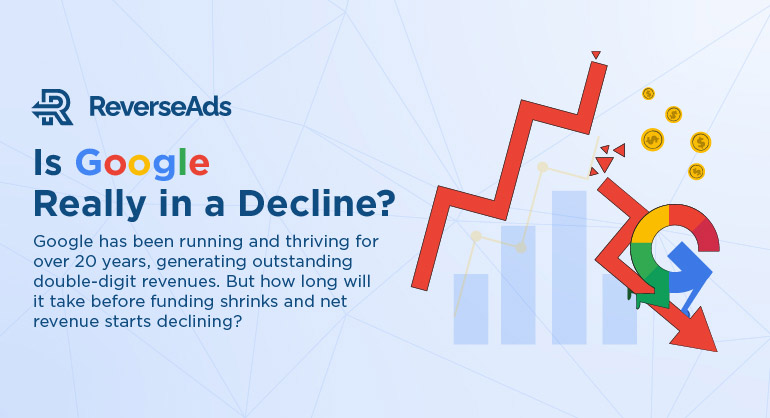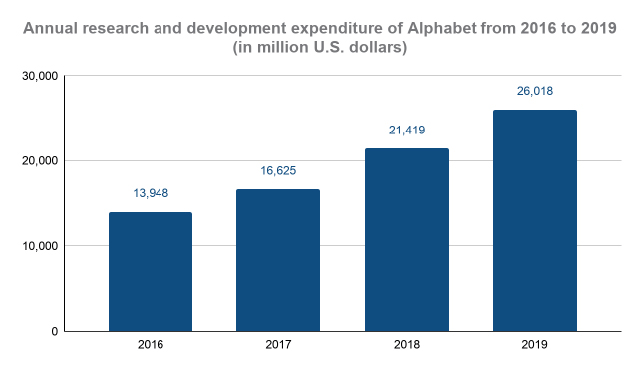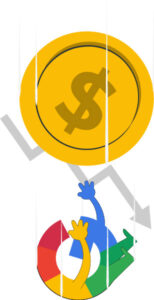Is Google Really In a Decline?

According to research, the average lifespan of an ad tech company is just 6 years: a strong correlation was found between the number of companies exiting in a year and the number of companies founded in the year t-6. The only companies that were not doomed to fail were those with healthy funding and net revenue greater than 100 million USD per year.
Google has been running and leading the industry for over 20 years, generating outstanding double-digit revenues. But how long will it take before funding shrinks and net revenue starts declining?
The digital advertising industry
Digital advertising is a thriving industry in constant evolution, where new players keep coming in and the competitive scenario becomes more challenging every day.
Over the course of 20 years, digital ads have evolved from simple, small display ads into hyper-specific marketing tools to target users based on their preferences, geographic location, recent searches and more.
Advertising giants such as Google and Facebook have been recording double-digit revenues ever since their inception, excluding the 2008 financial crisis which caused a brief decline. In 2019, their respective revenues amounted to 162 and 70 billion USD, with digital advertising services as the main source of income for both companies.
Google is a major leader in the industry, with over 29 billion ad impressions delivered each day between ads on its own site and ads on its network. In the attempt of delivering the highest amount of ads possible, Google has been constantly improving practices and developing innovative solutions that have kept the company among the top performers in the digital advertising industry for over 20 years.

How did Google become so powerful?
There’s always a well-thought growth strategy behind one’s success, and Google is no exception. By promoting innovation at the core of the company itself, Google has never limited its search for innovative ideas and approaches to its in-house talent. Over 20 years, the company has acquired more than 200 companies in 22 different countries, creating a valuable pool of talent that enabled them to stay ahead of the competition and become a leader in the digital advertising industry.
Through this strategy, focused on not imposing any limitations to creativity sourcing, Google has been able to repurpose old ideas and overcome the obstacles that once kept them from success. Creativity is key to innovation, and it is in this spirit that the company implemented policies to allow all employees to express their ideas at any time, no matter how absurd they might be. This has inevitably led to a constant flow of unique inputs that have made Google the tech giant it currently is.

New variables, new competitors: is Google really in a decline?
As the years passed by, new competitors started populating the scene, Google’s solid foundations began to tremble and the need to further innovate and outsmart the competition became imminent. These circumstances led to higher spending on operating revenue and R&D costs to develop new technologies and strategies, which consequently led to lower earnings per share over time.
In the attempt of staying one step ahead of other companies, Google enhanced its vast data collection practices to a level that was unprecedented, taking every opportunity to gather information about users as they started browsing on the web. Google’s products were free and innovative but required people to give up their personal data and their valuable attention to be used.
Simultaneously, users worldwide became increasingly aware of their privacy rights, and governments were called to implement stricter regulations for advertising companies to safeguard their citizens. These factors contributed to creating more challenges for Google, as its employees began to develop a sense of skepticism towards the company’s integrity and moral values, putting Google’s organizational culture legacy at risk.
Last but not least, in the current economic climate, uncertainty has reached its peak levels. The sudden, unexpected slowdown forced companies and individuals worldwide to repurpose their budgets, and start looking for alternatives to traditional search advertising, perhaps a more affordable solution that yielded the same results.
How does this all sum up?

Whether the decline will be permanent or just temporary depends on how well Google will cope with the consequences and on how other competitors will outsmart each other’s technology by providing valid alternatives to Google Ads, more suitable to the current economic conditions and more sustainable in the long run.
If you are looking for an alternative to traditional search ads, take a look at our ReverseAds products and learn more about our unique solution to drive more traffic and increase your conversion rate, all at a fraction of the cost of Google Ads.





